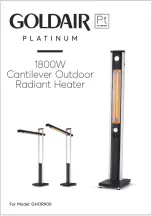
29
OPERATION AND SERVICE
OPERATION AND SERVICE
HOW IT WORKS
This section of the Service Handbook will cover operation, common service procedures and water heater construction. The water
heater covered in this Service Handbook has a helical shaped coil heat exchanger that is submerged in the storage tank. These water
heaters use a top mounted down fired radial design Burner. This is a forced draft burner; hot burning gases are forced through the heat
exchanger under pressure and exit through the exhaust/vent connection located at the bottom of the water heater.
Starting at the top air and fuel gas are drawn in by the Combustion Blower and Venturi. Flue gases and are forced through the helical
shaped heat exchanger by the Combustion Blower and out through the exhaust/vent outlet.
COMBUSTION BLOWER
The Combustion Blower is an assembly that includes the blower housing, blower motor and an electronic speed control. The
Combustion Blower is controlled by the CCB (Central Control Board) and is powered by a 3 pin wiring plug receiving 120 VAC from the
Junction Box.
The CCB sends a signal from the J5 socket to a 5 pin wiring socket on the blower. The signal is an electronic instruction to start, stop,
and control blower speed.
The Combustion Blower runs at higher speeds during the Pre/Post Purge operating states and runs at a lower speed during the Trial
For Ignition operating state. The Igniter Status icon is displayed on the UIM during the Trial For Ignition operating state.
MODULATION
The water heaters covered by this Service Handbook are capable of modulating their firing rate. The CCB monitors the water
temperature in the tank and regulates the firing rate to achieve the target temperature setpoint. The firing rate is dictated by the hot
water draw, proximity to the tank temperature setpoint, and various other temperature limitations. Ramping up and down of the blower
speed is considered normal operation of the water heater.
Service Note:
The 5 pin PWM signal plug MUST remain plugged in to the 5 pin socket on the blower assembly at all times. Disconnecting this plug will
cause the Combustion Blower to stop. If the electronic speed control is functioning properly Combustion Blower speed should
noticeably reduce during the Trial For Ignition operating state. If blower speed reduction does not occur during the Trial For Ignition
operating state ensure the 5 pin plug from the CCB is securely plugged into the matching 5 pin socket on the blower assembly and that
the J5 plug is securely plugged into the J5 socket on the CCB circuit board. Perform a close visual inspection of the pins inside the
plugs and sockets at the Combustion Blower and the CCB, replace any worn or damaged wiring harnesses as necessary.
















































